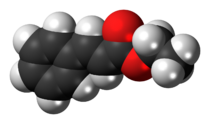Chemistry:Ethyl cinnamate
From HandWiki
Revision as of 03:58, 20 September 2021 by imported>TextAI2 (simplify)

| |

| |
| Names | |
|---|---|
| Preferred IUPAC name
Ethyl (2E)-3-phenylprop-2-enoate | |
| Other names
Ethyl cinnamate
| |
| Identifiers | |
3D model (JSmol)
|
|
| ChEMBL | |
| ChemSpider | |
PubChem CID
|
|
| UNII | |
| |
| |
| Properties | |
| C11H12O2 | |
| Molar mass | 176.21 g/mol |
| Density | 1.046 g/cm3 |
| Melting point | 6.5 to 8 °C (43.7 to 46.4 °F; 279.6 to 281.1 K) |
| Boiling point | 271 °C (520 °F; 544 K) |
| -107.5·10−6 cm3/mol | |
Except where otherwise noted, data are given for materials in their standard state (at 25 °C [77 °F], 100 kPa). | |
| Infobox references | |
Tracking categories (test):
Ethyl cinnamate is the ester of cinnamic acid and ethanol. It is present in the essential oil of cinnamon.[citation needed] Pure ethyl cinnamate has a "fruity and balsamic odor, reminiscent of cinnamon with an amber note".[1]
The p-methoxy derivative is reported to be a monoamine oxidase inhibitor.[2] It can be synthesized by the esterification reaction involving ethanol and cinnamic acid in the presence of sulfuric acid.
List of plants that contain the chemical
References
- ↑ Budavari, Susan (2001). "Merck Index 13th Ed.". Merck & Co., Inc.
- ↑ "Monoamine oxidase inhibitor from the rhizomes of Kaempferia galanga L". Chem Pharm Bull 31 (8): 2708–11. 1983. doi:10.1248/cpb.31.2708. PMID 6652816.
- ↑ Wong, K. C. et al. (2006). "Composition of the essential oil of rhizomes of kaempferia galanga L". Flavour and Fragrance Journal 7 (5): 263–266. doi:10.1002/ffj.2730070506.
- ↑ Othman, R. et al. (2006). "Bioassay-guided isolation of a vasorelaxant active compound from Kaempferia galanga L". Phytomedicine 13 (1–2): 61–66. doi:10.1016/j.phymed.2004.07.004. PMID 16360934.
 |

